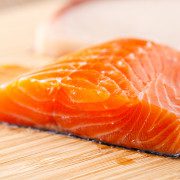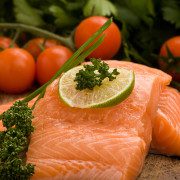Rosemary Honey-Glazed Salmon
Ingredients
- 1 tablespoons extra-virgin olive oil
- 2 1/2 pounds salmon skin on
- 1/4 cup Dijon mustard
- 1/4 cup honey
- 3 tablespoons fresh rosemary finely chopped
- 1 1/2 teaspoon salt
- 1/2 teaspoon black pepper coarsely ground
Adjust servings: servings
Units:
Instructions
- Preheat oven to 400 degrees. Brush 2 rimmed 17 by 12-inch baking pans with extra-virgin olive oil. Place half of salmon in center of pan of one pan. Repeat with the other pan, placing the second salmon in the second pan.
- In a small bowl mix together Dijon, honey and rosemary. Brush evenly over top of salmon then sprinkle with salt and pepper.
- Bake in preheated oven 18 - 20 minutes, or until center is just barely cooked through (it will cook another couple of minutes after it comes out of the oven. Remove and let rest 5 minutes. Cut salmon into portions. Serve warm.
Share this Recipe


